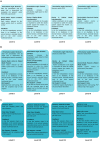I-BaR: integrated balance rehabilitation framework
- PMID: 39021504
- PMCID: PMC11252086
- DOI: 10.3389/fnbot.2024.1401931
I-BaR: integrated balance rehabilitation framework
Abstract
Neurological diseases are observed in approximately 1 billion people worldwide. A further increase is foreseen at the global level as a result of population growth and aging. Individuals with neurological disorders often experience cognitive, motor, sensory, and lower extremity dysfunctions. Thus, the possibility of falling and balance problems arise due to the postural control deficiencies that occur as a result of the deterioration in the integration of multi-sensory information. We propose a novel rehabilitation framework, Integrated Balance Rehabilitation (I-BaR), to improve the effectiveness of the rehabilitation with objective assessment, individualized therapy, convenience with different disability levels and adoption of assist-as-needed paradigm and, with integrated rehabilitation process as whole, that is, ankle-foot preparation, balance, and stepping phases, respectively. Integrated Balance Rehabilitation allows patients to improve their balance ability by providing multi-modal feedback: visual via utilization of virtual reality; vestibular via anteroposterior and mediolateral perturbations with the robotic platform; proprioceptive via haptic feedback.
Keywords: anticipatory postural adjustment; balance rehabilitation; compensatory postural adjustment; multi-modal sensory feedback; rehabilitation methodology; robotic rehabilitation.
Copyright © 2024 Ersoy, Kaya, Hocaoglu and Unal.
Conflict of interest statement
The authors declare that the research was conducted in the absence of any commercial or financial relationships that could be construed as a potential conflict of interest.
Figures



Similar articles
-
Effects of kinesthetic haptic feedback on standing stability of young healthy subjects and stroke patients.J Neuroeng Rehabil. 2015 Mar 13;12:27. doi: 10.1186/s12984-015-0020-x. J Neuroeng Rehabil. 2015. PMID: 25889581 Free PMC article.
-
Balance rehabilitation: promoting the role of virtual reality in patients with diabetic peripheral neuropathy.J Am Podiatr Med Assoc. 2013 Nov-Dec;103(6):498-507. doi: 10.7547/1030498. J Am Podiatr Med Assoc. 2013. PMID: 24297986
-
Postural adaptation in elderly patients with instability and risk of falling after balance training using a virtual-reality system.Int Tinnitus J. 2006;12(1):41-4. Int Tinnitus J. 2006. PMID: 17147038
-
Virtual reality applications in improving postural control and minimizing falls.Conf Proc IEEE Eng Med Biol Soc. 2006;2006:2694-7. doi: 10.1109/IEMBS.2006.260751. Conf Proc IEEE Eng Med Biol Soc. 2006. PMID: 17946975 Review.
-
Vibrotactile-Based Rehabilitation on Balance and Gait in Patients with Neurological Diseases: A Systematic Review and Metanalysis.Brain Sci. 2021 Apr 19;11(4):518. doi: 10.3390/brainsci11040518. Brain Sci. 2021. PMID: 33921655 Free PMC article. Review.
References
-
- Agrbas O., Aggon E., Oz R. (2019). The development a new device to measure of audial and visual reaction time in hand and foot (validity and reliability study). Int. Educ. Stud. 12:165. 10.5539/ies.v12n4p165 - DOI
-
- Allin L. J., Brolinson P. G., Beach B. M., Kim S., Nussbaum M. A., Roberto K. A., et al. . (2020). Perturbation-based balance training targeting both slip- and trip-induced falls among older adults: a randomized controlled trial. BMC Geriatr. 20, 1–13. 10.1186/s12877-020-01605-9 - DOI - PMC - PubMed
-
- Aloraini S. M., Glazebrook C. M., Pooyania S., Sibley K. M., Singer J., Passmore S. (2020). An external focus of attention compared to an internal focus of attention improves anticipatory postural adjustments among people post-stroke. Gait Posture 82, 100–105. 10.1016/j.gaitpost.2020.08.133 - DOI - PubMed
LinkOut - more resources
Full Text Sources

